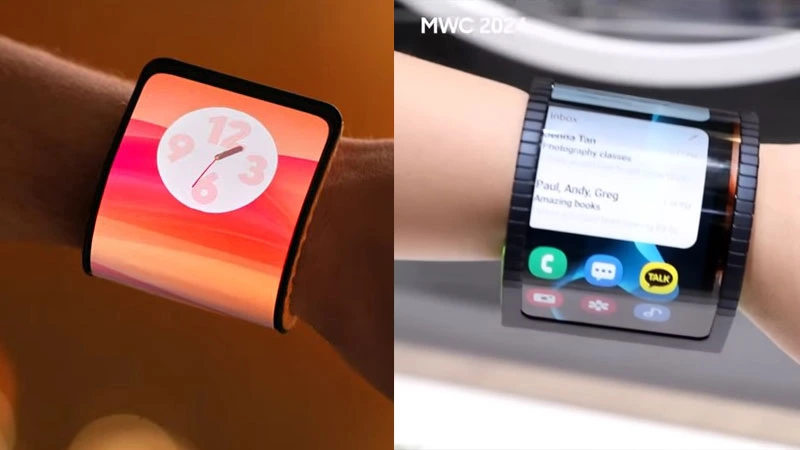In the dynamic landscape of technological innovation, Motorola has turned heads at the Mobile World Congress 2024 in Barcelona with the introduction of a groundbreaking concept – a bendable and moldable smartphone. This 6.9-inch marvel features a flexible plastic-based pOLED display, a woven texture, and multiple hinges, pushing the boundaries of traditional smartphone design.
The Shape-Shifting Marvel
Motorola’s concept phone goes beyond mere flexibility; it’s moldable, allowing users to shape their phones according to their preferences. The device boasts a woven-fabric back material, reminiscent of the Apple Vision Pro’s headband, concealing the bendable display and clever hinge technology within its sleek design.
Transformative Configurations
This phone delivers a traditional smartphone experience with an Android interface. What sets it apart is its ability to transform into various configurations. The Adaptive Display can wrap around the wrist, morphing into a 6.9-inch smartwatch, introducing a new era of customizable wearables. Beyond this, the device offers modes like “tent mode” for gaming and a stand mode, enhancing versatility.
Dynamic User Interface
The user interface dynamically adjusts to match the device’s configuration, providing seamless control of apps and functions. The stylish orange fabric backing and adds a touch of flair features a secure magnetic attachment mechanism, preventing the phone from slipping off the wrist during use. However, questions linger about the comfort and practicality of prolonged wear in wrist mode.
Challenges and Questions
While the concept is undeniably innovative, shape-shifting phones pose several challenges. Constantly changing shapes might lead to device weakness over time, potential damage, and increased risk of mechanical failures. The technology demands more energy, potentially impacting battery life or necessitating heavier batteries. Users may find it challenging to adapt to a shifting form factor, raising concerns about practicality and frustration.
Moreover, the development costs and potential repair complexities could make these phones inaccessible to many consumers. Compatibility issues with apps designed for traditional form factors further complicate the adoption of shape-shifting phones.
Future Prospects
Acknowledging these challenges, it’s crucial to recognize that this is a concept device. Motorola is likely to address these concerns in subsequent iterations, refining the technology and making it more accessible to the public. The journey from concept to commercial availability is expected to involve extensive development and testing.
Flexible beyond imagination. Our Adaptive Display Proof of Concept is the showstopper at #MWC2024! #MWC24 #hellomoto pic.twitter.com/afJDapJ5Ez
— motorola (@Moto) February 28, 2024
Samsung’s OLED Cling Band
At the same event, Samsung presented its prototype, the ‘OLED Cling Band,’ showcasing a 6.9-inch bendable phone that can be worn on the wrist. While similar to Motorola’s concept, it features a camera, loudspeaker, and USB Type-C port. The OLED Cling Band’s UI adapts to the phone’s bent state, offering a complete user experience.
Fitness Integration and Practicality
Diverging from Motorola’s approach, Samsung’s prototype incorporates a rear heart rate sensor, turning the phone into a fitness band when worn on the wrist. However, practicality concerns arise, as wearing a substantial smartphone continuously can be uncomfortable and impractical for activities like sleep tracking.
The Road Ahead for Bendable Phones
The concept of wearing a smartphone on the wrist presents exciting possibilities, showcasing the evolution of display technology. However, both Motorola’s and Samsung’s prototypes highlight the current impracticalities and challenges associated with shape-shifting phones. These innovations serve as a glimpse into the future, emphasizing the need for further refinement and addressing user concerns before widespread adoption.
FAQ’s
How do shape-shifting phones impact app compatibility?
The dynamic nature of shape-shifting phones may pose compatibility issues with apps designed for traditional form factors. Developers need to adapt their applications to ensure seamless performance across different configurations.
Bottom Up
Motorola’s bendable phone showcased at the MWC 2024 introduces an exciting era of shape-shifting smartphones, redefining user customization and versatility. While the concept demonstrates remarkable innovation, challenges such as durability, energy consumption, and user adaptation must be addressed for widespread adoption. Samsung’s OLED Cling Band adds another dimension to this exploration, emphasizing the ongoing evolution of display technology.
As these prototypes pave the way for future developments, the path to commercial viability will involve refining these groundbreaking ideas, ensuring they not only captivate the imagination but also seamlessly integrate into the practicalities of everyday life. The journey from concept to consumer-ready will undoubtedly be intriguing, holding the promise of a dynamic and personalized smartphone experience.

